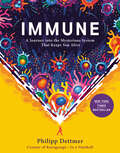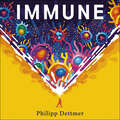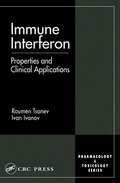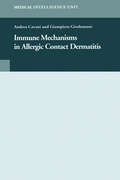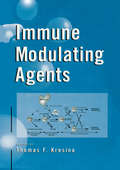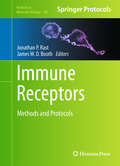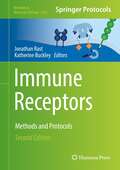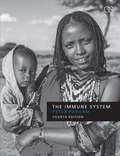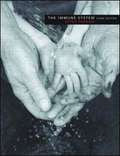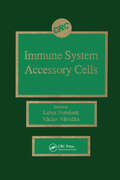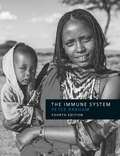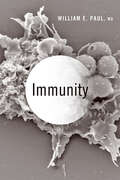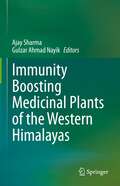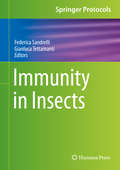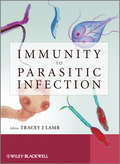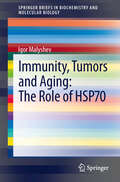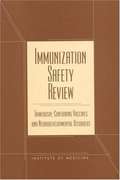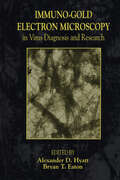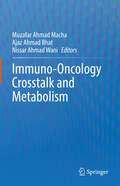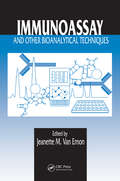- Table View
- List View
Immune: A Journey into the Mysterious System That Keeps You Alive
by Philipp DettmerA gorgeously illustrated deep dive into the immune system that will forever change how you think about your body, from the creator of the popular science YouTube channel Kurzgesagt—In a Nutshell “Through wonderful analogies and a genius for clarifying complex ideas, Immune is a truly brilliant introduction to the human body’s vast system for fighting infections and other threats.”—John Green, #1 New York Times bestselling author of The Fault in Our Stars <P><P>You wake up and feel a tickle in your throat. Your head hurts. You’re mildly annoyed as you get the kids ready for school and dress for work yourself. Meanwhile, an epic war is being fought, just below your skin. Millions are fighting and dying for you to be able to complain as you head out the door. But most of us never really stop to ask: What even is our immune system? <P><P>Second only to the human brain in its complexity, it is one of the oldest and most critical facets of life on Earth. Without it, you would die within days. In Immune, Philipp Dettmer, the brains behind the most popular science channel on YouTube, takes readers on a journey through the fortress of the human body and its defenses. There is a constant battle of staggering scale raging within us, full of stories of invasion, strategy, defeat, and noble self-sacrifice. In fact, in the time you&’ve been reading this, your immune system has probably identified and eradicated a cancer cell that started to grow in your body. <P><P>Each chapter delves into an element of the immune system, including defenses like antibodies and inflammation as well as threats like bacteria, allergies, and cancer, as Dettmer reveals why boosting your immune system is actually nonsense, how parasites sneak their way past your body's defenses, how viruses work, and what goes on in your wounds when you cut yourself. <P><P>Enlivened by engaging full-color graphics and immersive descriptions, Immune turns one of the most intricate, interconnected, and confusing subjects—immunology—into a gripping adventure through an astonishing alien landscape. Immune is a vital and remarkably fun crash course in what is arguably, and increasingly, the most important system in the body. <P><P><b>A New York Times Best Seller</b>
Immune: The new book from Kurzgesagt - a deep dive into the immune system
by Philipp DettmerA deep dive into the immune system that will forever change how you think about your body - how it works and why it is both your greatest ally and most dangerous enemy - from the creator of the popular science YouTube channel Kurzgesagt - In a Nutshell.'A truly brilliant introduction to the human body's vast system for fighting infections and other threats'JOHN GREEN, #1 New York Times bestselling author of The Fault in Our Stars'Reads as if it's a riveting sci-fi novel . . . a delightful treat for the curious'TIM URBAN, creator of Wait But Why**************You wake up and feel a tickle in your throat. Your head hurts. You're mildly annoyed as you get the kids ready for school and dress for work yourself. Meanwhile, an utterly epic war is being fought, just below your skin. Millions are fighting and dying for you to be able to complain as you drink your cup of tea and head out the door.So what, exactly, IS your immune system?Second only to the human brain in its complexity, it is one of the oldest and most critical facets of life on Earth. Without it, you would die within days. In Immune, Philipp Dettmer, the brains behind the most popular science channel on YouTube, takes listeners on a journey through the fortress of the human body and its defences. There is a constant battle of staggering scale raging within us, full of stories of invasion, strategy, defeat, and noble self-sacrifice. In fact, in the time you've been listening to this, your immune system has probably identified and eradicated a cancer cell that started to grow in your body.Each chapter delves deeply into an element of the immune system, including defences like antibodies and inflammation as well as threats like viruses, bacteria, allergies and cancer, as Dettmer reveals why boosting your immune system is actually nonsense, how parasites sneak their way past your body's defences, how viruses - including the coronavirus - work, and what goes on in your wounds when you cut yourself.Enlivened by immersive descriptions, Immune turns one of the most intricate, interconnected, and confusing subjects - immunology - into a gripping adventure through an astonishing alien landscape.Challenging what you know and think about your own body and how it defends you against all sorts of maladies and how it might also eventually be your own downfall, Immune is a vital and remarkably fun crash course in what is arguably, and increasingly, the most important system in the body.(P) 2021 Hodder & Stoughton Limited
Immune Cells, Inflammation, and Cardiovascular Diseases (Methods in Signal Transduction Series)
by Shyam S. BansalInflammation, once considered a physiological response to foreign pathogens, is now recognized as a crucial pathological player in the initiation and progression of several chronic diseases, including diabetes, obesity, cancer, Alzheimer’s disease, Parkinson’s disease, and many others. Considering that cardiovascular diseases are a leading cause of death in the United States and worldwide, the identification of critical inflammatory processes is of utmost importance to devising new immune-based therapeutics that can be added to existing regimens. This book provides detailed information on aspects of inflammation and the manner in which immune activation pathways affect the progression of cardiovascular diseases and the repair/regeneration mechanisms of underlying diseased tissues. Key Features Outlines the role that inflammation plays in cardiovascular diseases Describes a paradox – neutralization of cytokines that contribute to cardiovascular disease does not show benefit Summarizes research on a variety of processes and mechanisms contributing to cardiovascular pathology Contributions from an international team of leading cardiologists and cardiovascular immunologists Related Titles Roy, S., et al., eds. Chronic Inflammation: Molecular Pathophysiology, Nutritional and Therapeutic Interventions (ISBN 978-1-138-19955-2) Kong, A-N. T., ed. Inflammation, Oxidative Stress, and Cancer: Dietary Approaches for Cancer Prevention (ISBN 978-1-138-19984-2) Dick, A., et al. Practical Manual of Intraocular Inflammation (ISBN 978-0-367-38720-4)
Immune Interferon: Properties and Clinical Applications (Pharmacology and Toxicology: Basic and Clinical Aspects)
by Roumen G. Tsanev Ivan IvanovNow for the first time, one comprehensive book summarizes and analyzes the numerous scientific papers and reviews covering selected aspects of the structure, biological activities, and clinical effects of immune interferon, also known as interferon-gamma(IFN-gamma). Interferon-gamma is a natural immune booster which has been synthesized and widely used in clinical cases ranging from infectious diseases to cancer, as well as various metabolic disorders. Having developed their own brand of interferon-gamma, the authors are well known in the scientific community. In Immune Interferon: Properties and Clinical Applications, they bring together the extensive findings from twenty years of research since the discovery of the drug. Focusing on the drug itself, and not particular brands, the book presents data on the properties of interferon-gamma, experimental data on its effects, and its clinical applications.
Immune Mechanisms in Allergic Contact Dermatitis
by Andrea CavaniThis book presents an overview of the pathogenesis of allergic contact dermatitis (ACD). It explains the characterization of T cell subsets which modulate immune reaction to chemicals and may represent a formidable tool for new therapeutic approaches to ACD and other T cell-mediated skin disorders.
The Immune Mind: The Hidden Dialogue Between Your Brain and Immune System
by Monty LymanDelving into the recent discovery of the brain's immune system, Dr. Monty Lyman reveals the extraordinary implications for our physical and mental health.Until a decade ago, we misunderstood a fundamental aspect of human health. Although the brain and the body have always been viewed as separate entities—treated in separate hospitals—science now shows that they are intimately linked.Startlingly, we now know that our immune system is in constant communication with our brain and can directly alter our mental health. This has opened up a new frontier in medicine. Could inflammation cause depression, and could arthritis drugs cure it? Can gut microbes alter your mood? Can something as simple as brushing your teeth properly reduce your risk of dementia? Could childhood infections lie behind neurological and psychiatric disorders such as tics and obsessive compulsive disorder?In The Immune Mind, Dr. Monty Lyman explores the fascinating connection between the mind, immune system, and microbiome. A specialist in the cutting-edge field of immuno-psychiatry, Lyman argues that we need to change the way we treat disease and the way we see ourselves. For the first time, we have a new approach to medicine that treats the whole human being.
Immune Modulating Agents
by Thomas F. KresinaDiscussing the systemic immune response in the contexts of health, disease, and therapy, this unique resource-the only broadly based book of its kind available on the subject-offers comprehensive examinations of the pathways and agents that affect the human immune response and provides state-of-the-art presentations on practical methods of immune modulation. Focuses on the immune response and modulation in infectious diseases, such as HIV, hepatitis, and parasitic infections and highlights immune modulating agents in gastrointestinal diseases, sepsis, cancer, and autoimmunity! Written by over 50 international authorities representing distinguished institutions in nine countries, Immune Modulating Agentsintroduces basic immunoregulatory mechanisms as homeostasis details cytokines, cellular and humoral immune responses, and hematopoiesis describes neuroendocrine - immune system interactions and the role of psychological stress on immune competence delineates factors that influence disease susceptibility, including nutrition covers drug delivery systems, gene therapy, organ transplantation, arthritis treatment, and vaccination strategies shows how to design clinical trials using immune modulating agents and more!
Immune Receptors
by James W.D. Booth Jonathan P. RastImmunology has made significant progress in the past decade, driven forward by rapidly advancing technology and a renewed interest in the vast realm of innate immunity. The receptors that mediate these functions are at the front lines of both protective and regulative roles of the immune system. In Immune Receptors: Methods and Protocols, expert researchers present a variety of experimental approaches to the characterization of immune receptors and the cell biology that mediates their functions. These include imaging techniques that aim to understand receptor localization and trafficking, techniques to measure receptor-ligand interactions, strategies to identify novel ligands and methods to analyze downstream receptor signaling, as well as strategies for genomic and proteomic characterization of receptor repertoires. Written in the highly successful Methods in Molecular BiologyTM series format, chapters include introductions to their respective subjects, lists of the necessary materials and reagents, step-by-step, readily reproducible laboratory protocols, and tips on troubleshooting and avoiding known pitfalls. Authoritative and practical, Immune Receptors: Methods and Protocols offers technical descriptions and protocols that will be useful both to investigators who are interested in carrying out these procedures and to those who seek a deeper understanding of the bench science that lies behind the immunology literature.
Immune Receptors: Methods and Protocols (Methods in Molecular Biology #2421)
by Jonathan Rast Katherine BuckleyThis volume explores immune cell receptors that are used in the detection of microbes, either by binding directly to non-self molecules or through indirectly sensing microbe-associated cellular disturbances. The chapters in this book cover methods for studying receptor-ligand interactions at both molecular and cellular levels; methods to create and characterize novel antibody reagents; and methods to characterize the molecular processes that lead to adaptive receptor maturation. This book also contains chapters that look at high-throughput strategies that describe the diversity of immune receptors and cells. Written in the highly successful Methods in Molecular Biology series format, chapters include introductions to their respective topics, lists of the necessary materials and reagents, step-by-step, readily reproducible laboratory protocols, and tips on troubleshooting and avoiding known pitfalls.Cutting-edge and authoritative, Immune Receptors: Methods and Protocols, Second Edition is a valuable resource for scientists and researchers interested in learning more about this developing field.
Immune Responses to Biosurfaces
by John D. Lambris Kristina N. Ekdahl Daniel Ricklin Bo NilssonThe collection of chapters in this proceedings volume brings together research from academic and industry scientists and clinical development experts who are focused on contemporary and emerging aspects of improving treatments employing biosurfaces. Interactions between biomaterial implants, devices, cell therapies, and whole organ transplants frequently trigger activation of body defense systems and responses that negatively affect the clinical outcome. Optimal tissue integration and modulation of foreign body reactions is therefore essential for preserving anticipated functions and avoiding adverse effects. Topics covered include mechanistic and applied research within the fields of extracorporeal devices, soft and hard tissue implants, tissue and biomaterial-targeting, therapeutic modulation of foreign body reactions, cell encapsulations, as well as cell and whole organ transplantation.
The Immune Synapse: Methods and Protocols (Methods in Molecular Biology #2654)
by Cosima T. Baldari Michael L. DustinThis new collection features the most up-to-date essential protocols that are currently being used to study the immune synapse. Beginning with methods for making biophysical measurements, the volume continues by covering the cell biology of synapses, methods for advanced substrate engineering, mechanobiology topics, new technologies to describe and manipulate synaptic components, as well as methods related to sites of action and immunotherapy. Written for the highly successful Methods in Molecular Biology series, chapters include introductions to their respective topics, lists of the necessary materials and reagents, step-by-step and readily reproducible laboratory protocols, and tips on troubleshooting and avoiding known pitfalls. Authoritative and fully updated, The Immune Synapse: Methods and Protocols, Second Edition serves as an ideal practical guide for researchers working in this dynamic field. Chapters 5, 11, 18, 27, 30, and 32 are available open access under a Creative Commons Attribution 4.0 International License via link.springer.com.
The Immune System
by Peter ParhamThe Immune System, Fourth Edition emphasizes the human immune system and presents immunological concepts in a coherent, concise, and contemporary account of how the immune system works. Written for undergraduate, medical, veterinary, dental, and pharmacy students, it makes generous use of medical examples to illustrate points. This classroom-proven
The Immune System (3rd edition)
by Peter ParhamParham (structural biology, microbiology, immunology, Stanford U.) offers a third edition to his textbook explaining the functions of the human immune system. It is specifically intended for undergraduate students in medical, dental, and pharmacy in immunology courses. Extensively updated, the textbook includes new chapters on innate and adaptive immunity, enhanced treatment of aspects of innate immunity such as the complement system and defensins, immunotherapies, and the nature of immune response in mucosal tissues and immunological memory. It is well-illustrated and includes essay, multiple choice, and case study questions at the conclusion of each chapter. Annotation ©2009 Book News, Inc., Portland, OR (booknews.com)
Immune System Accessory Cells
by Lubor Fornusek Vaclav VetvickaImmune System Accessory Cells provides a comprehensive survey of all types of antigen-presenting and accessory cells. Macrophages are emphasized through descriptions of different types of endocytosis, other major properties, and all basic and new information concerning macrophages as antigen-presenting cells. Other topics covered include the impact of the immunodeficient state on accessory functions, the evolutionary emergence of accessory functions, and the role of various cell types in defense reactions in major assemblages of Metazoa. The book also presents a chapter describing the phylogenetic aspects of accessory functions, which traces the first accessory cells during the evolution of living matter.Immune System Accessory Cells is an excellent reference for immunologists, cell biologists, and others interested in developing an understanding of the roles of accessory cells in all facets of immune reactions.
The Immune System (Fourth Edition)
by Peter ParhamThe Immune System, Fourth Edition emphasizes the human immune system and presents immunological concepts in a coherent, concise, and contemporary account of how the immune system works. Written for undergraduate, medical, veterinary, dental, and pharmacy students, it makes generous use of medical examples to illustrate points. This classroom-proven textbook offers clear writing, full-color illustrations, and section and chapter summaries that make the book accessible and easily understandable to students. The Fourth Edition is a major revision that brings the content up-to-date and improves clarity. Based on user feedback, there is now increased continuity and connectivity between chapters. The Immune Systemis additionally supported by the Garland Science Learning System. This homework platform is designed to evaluate and improve student performance and allows instructors to select assignments on specific topics and review the performance of the entire class, as well as individual students, via the instructor dashboard. Students receive immediate feedback on their mastery of the topics, and will be better prepared for lectures and classroom discussions. The user-friendly system provides a convenient way to engage students while assessing progress. Performance data can be used to tailor classroom discussion, activities, and lectures to address students' needs precisely and efficiently. For more information and sample material, visit http://garlandscience. rocketmix. com/. A free trial for the Garland Science Learning System will be available to use during the Fall 2016 and Spring 2017 semesters. Please contact us directly at science@garland. comto sign up!
Immunity: Innate Immunity (Advances In Experimental Medicine And Biology Ser. #560)
by William E. PaulA leading figure in immunology takes readers inside the remarkably powerful human immune system.Winner of the CHOICE Outstanding Academic Title of the Choice ACRLThe immune system has incredible power to protect us from the ravages of infection. Boosted by vaccines, it can protect us from diseases such as measles. However, the power of the immune system is a double-edged sword: an overactive immune system can wreak havoc, destroying normal tissue and causing diseases such as type I diabetes, rheumatoid arthritis, and multiple sclerosis. The consequences of an impaired immune system, on the other hand, are all too evident in the agonies of AIDS.Packed with illustrations, stories from Dr. William E. Paul’s distinguished career, and fascinating accounts of scientific discovery, Immunity presents the three laws of the human immune system—universality, tolerance, and appropriateness—and explains how the system both protects and harms us. From the tale of how smallpox was overcome and the lessons of the Ebola epidemic to the hope that the immune system can be used to treat or prevent cancer, Dr. Paul argues that we must take advantage of cutting-edge technologies and promising new tools in immunological research.
Immunity: How Elie Metchnikoff Changed the Course of Modern Medicine
by Luba VikhanskiAround Christmas of 1882, while peering through a microscope at starfish larvae in which he had inserted tiny thorns, Russian zoologist Elie Metchnikoff had a brilliant insight: what if the mobile cells he saw gathering around the thorns were the same as white blood cells that traveled to the site of an injury or infection in a human or other animal? Was this some form of cellular defense? Metchnikoff's theory of immunity, that phagocytes--white blood cells--formed the first line of defense against invading bacteria would eventually earn the scientist the unofficial moniker "Father of Natural Immunity" and a Nobel Prize. But first, he had to convince his colleagues, including the skeptical Robert Koch. Author Luba Vikhanski chronicles Metchnikoff's remarkable life, work, and discoveries in Immunity, the first modern biography of this hero of medicine. Metchnikoff was a towering figure in the scientific community of the early 20th century, a tireless humanitarian who worked to curb cholera, syphilis, and other diseases, and pioneered research into probiotics and gerontology. Though Metchnikoff is largely forgotten today, Vikhanski makes a compelling case that his work on natural immunity is finally receiving the attention it deserves.
Immunity Boosting Medicinal Plants of the Western Himalayas
by Ajay Sharma Gulzar Ahmad NayikThis book presents a comprehensive guide to traditional immunity-boosting medicinal plants of the Himalayas, their traditional uses, phytochemistry, pharmacology, diversity, conversation, biotechnology, toxicology, as well as future prospective. All the chapters cover the latest advances in ethnobotany, phytochemistry, biochemistry, and biotechnology. The book offers a valuable asset for researchers and graduate students of chemistry, botany, biotechnology, microbiology, and the pharmaceutical sciences. The main purpose of the present book is to draw on the rich culture, folklore, and biodiversity of immunity-boosting medicinal plants of the Western Himalayas, with particular emphasis on the Indian Trans-Himalayan and Western Himalayan region. All the plants included in the present book are extensively used by the local tribes and people for their health-promoting properties from ancient times. This book will be a substantial contribution to the knowledge of the region and the country. Also, the book will be very useful to scientists, graduates, and undergraduates, along with researchers in the fields of natural products, herbal medicines, ethnobotany, pharmacology, chemistry, and biology. Further, it is an equally significant resource for a person working in different traditional medicinal systems; doctors (especially those engaged in Ayurveda, Chinese traditional medicinal system, Amchi, and allopathy); the pharmaceutical industry (for drug design and synthesis); biochemistry and biotechnology sciences; and the agricultural sciences.
Immunity in Insects (Springer Protocols Handbooks)
by Federica Sandrelli Gianluca TettamantiThis volume details methods and protocols necessary to further the study of insect immunity. Chapters guide readers through up-to-date genomic and transcriptomic approaches, insect samples for proteomic analysis, hemocytes in Drosophila, cellular response in Lepidoptera, insect AMPs, manipulate the composition of mosquito microbiota, viral infections in insects, infections by entomopathogenic nematodes, immune response following oral infections, and protocols to to monitor the effect of septic infections with human pathogens using B. mori as a model. Written in the highly successful Methods in Molecular Biology series format, chapters include introductions to their respective topics, lists of the necessary materials and reagents, step-by-step, readily reproducible laboratory protocols, and tips on troubleshooting and avoiding known pitfalls. Authoritative and cutting-edge, Immunity in Insects aims to ensure successful results in the further study of this vital field.
Immunity to Parasitic Infection
by Tracey LambParasitic infections remain a significant cause of morbidity and mortality in the world today. Often endemic in developing countries many parasitic diseases are neglected in terms of research funding and much remains to be understood about parasites and the interactions they have with the immune system. This book examines current knowledge about immune responses to parasitic infections affecting humans, including interactions that occur during co-infections, and how immune responses may be manipulated to develop therapeutic interventions against parasitic infection.For easy reference, the most commonly studied parasites are examined in individual chapters written by investigators at the forefront of their field. An overview of the immune system, as well as introductions to protozoan and helminth parasites, is included to guide background reading. A historical perspective of the field of immunoparasitology acknowledges the contributions of investigators who have been instrumental in developing this field of research.
Immunity, Tumors and Aging: The Role of HSP70
by Igor MalyshevThe book is dedicated to the topical area of biology and medicine and the role of stress proteins HSP70 in the regulation of intracellular protein homeostasis, signaling transduction and cell protection. The book is divided into chapters, which describe the discovery of HSP70 and its molecular structure, the mechanism of the synthesis and function in normal and damaged cells, examine the role of HSP70 in immunity, cancerogenesis, aging, Alzheimer's disease and cardiac surgery. In this book, the author looks at HSP70 as a factor which prevents the transformation of homeostasis mechanisms of intracellular proteins into a link in the pathogenesis of a disease.
Immunization Safety Review: Thimerosal-containing Vaccines And Neurodevelopmental Disorders
by Institute of MedicienInformation on Thimerosal-containing Vaccines And Neurodevelopmental Disorders
Immuno-Gold Electron Microscopy in Virus Diagnosis and Research
by Alexander D. Hyatt Bryan EatonThis book presents a wide variety of immuno-gold techniques for use in virus diagnosis and research. Protocols are presented for state-of-the-art techniques, including in situ hybridization, freeze substitution, and the utilization of ultra-small probes and replicas for use by virologists and electron microscopists identifying and studying viruses, their components, and replication in cells. The procedures are described by eminent scientists and are pertinent to both experienced researchers and newcomers to this field who are interested in the localization of low antigenic mass structures.
Immuno-Oncology Crosstalk and Metabolism
by Muzafar Ahmad Macha Ajaz Ahmad Bhat Nissar Ahmad WaniThis book discusses the novel metabolic cross-talk between immune and tumor cells in the tumor microenvironment that promotes their growth and progression. It also describes deregulated metabolism in cancer cells that promotes suppressive and cancer cell-favourable microenvironment. Further, the book provides novel insights on the metabolic changes in immune cells that promote tumor cell growth and survival. In turn, it also reviews the involvement of immuno-onco metabolic cross-talk in the development of resistance to chemo-radiation therapy (CRT) in tumor cells. Lastly, it also explores the potential of immuno-oncology metabolism as a therapeutic approach against tumor cells.
Immunoassay and Other Bioanalytical Techniques
by Jeanette M. Van EmonTaking an interdisciplinary approach that emphasizes the adaptability of immunochemical and related bioanalytical methods to a variety of matrices, Immunoassay and Other Bioanalytical Techniques describes the strength and the versatility of these methods in a wide range of environmental and biological measurement applications. With contribut
